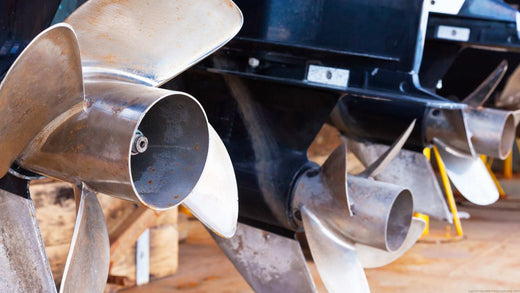
How to Measure Your Boat’s Propeller
Nicholas HeislerShare
When it comes to maximizing your boat's performance and efficiency, few components are as important as the propeller. Whether you're upgrading, replacing, or simply trying to understand your current setup, knowing how to measure a boat propeller is essential. Accurate measurements ensure compatibility with your boat and engine, resulting in better fuel efficiency, smoother rides, and optimal speeds. In this guide, we'll walk you through the process of measuring a boat propeller step by step, explain why it matters, and share expert tips to get the job done right.
Understanding Boat Propellers
A boat propeller isn't just a simple piece of hardware; it's a complex and crucial part of your vessel. The propeller's primary job is to convert the engine's power into thrust, moving your boat forward (or backward) through water. Propellers come in various shapes, sizes, and designs, and choosing the right one can drastically affect your boat's performance.
Key Components of a Propeller:
-
Blades: The rotating arms that push water to create thrust.
-
Hub: The central part of the propeller that connects to the engine shaft.
-
Diameter and Pitch: Key measurements that determine the propeller's size and performance characteristics.
Why does the right propeller size matter? Using a propeller that doesn't match your boat's engine or intended use can lead to issues like poor acceleration, reduced fuel efficiency, and even damage to the engine. That's why measuring your propeller is so important.
Tools You'll Need to Measure a Boat Propeller
Before diving into the measurement process, it's important to gather the right tools. Having these on hand will make the process smoother and ensure accurate results:
-
Measuring tape or ruler (preferably one with millimeter and inch markings).
-
Calipers (for more precise measurements).
-
A flat surface to lay the propeller on.
-
A notepad or device to record your measurements.
Pro Tip: Clean your propeller thoroughly before measuring it. Dirt, barnacles, or debris can interfere with accurate readings.
Step-by-Step Guide to Measuring a Boat Propeller
Step 1: Measure the Diameter
The diameter is one of the most critical measurements of a propeller. It's the distance across the circle that the propeller creates as it rotates.
-
Lay the propeller flat on a level surface.
-
Measure the distance from the center of the hub to the tip of one blade. This gives you the radius.
-
Multiply the radius by 2 to calculate the diameter.
For example, if the radius is 6 inches, the diameter will be 12 inches. If your propeller has multiple blades of varying lengths, measure each blade's radius and use the largest value to calculate the diameter.
Step 2: Measure the Pitch
The pitch of a propeller refers to the theoretical distance the propeller moves forward in one complete rotation, assuming no slippage. In simple terms, it's how far the boat would travel per rotation if the propeller were moving through a solid material.
-
Look for the pitch marking on the propeller (often stamped on the hub).
-
If the marking isn't visible, you can calculate the pitch by comparing the angle of the blades to the diameter. This process often requires specialized tools or consulting a professional.
Step 3: Count the Number of Blades
The number of blades affects the propeller's performance:
-
3-blade propellers are common and offer a good balance of speed and efficiency.
-
4-blade propellers provide more thrust and smoother rides, especially in rough waters.
Simply count the number of blades to complete this step. Be sure to consider your boat's intended use when choosing between 3-blade and 4-blade options.
Step 4: Check the Hub Size
The hub is the central part of the propeller that fits onto the engine's shaft. Measuring the hub size ensures the propeller will be compatible with your engine.
-
Measure the diameter of the hub's opening using calipers or a measuring tape.
-
Check the spline count (the number of grooves inside the hub that match the engine shaft).
Step 5: Record the Propeller Specifications
Once you've measured the diameter, pitch, number of blades, and hub size, write these specifications down. Having this information on hand will make it easier to purchase a replacement propeller or troubleshoot performance issues.
Common Mistakes to Avoid When Measuring a Propeller
-
Skipping Steps: Ensure you measure all aspects of the propeller, not just the diameter or pitch.
-
Using Improper Tools: Inaccurate tools lead to inaccurate measurements.
-
Ignoring Manufacturer Markings: Most propellers have key specifications stamped on the hub; always double-check these before measuring manually.
-
Overlooking Blade Variations: If one blade is damaged or shorter, it can skew your diameter measurement. Always use the longest blade for accuracy.
When to Replace Your Boat Propeller
Even the best-maintained propellers don't last forever. Here are some signs it's time to replace your propeller:
-
Visible Damage: Chips, cracks, or bent blades.
-
Poor Performance: Reduced speed, sluggish acceleration, or increased fuel consumption.
-
Engine Strain: Over-revving or difficulty maintaining consistent RPMs.
Replacing your propeller involves measuring the current one to find a suitable replacement. By following the steps above, you can confidently shop for a new propeller that meets your needs.
FAQs About Measuring Boat Propellers
1. What does the pitch on a propeller mean?
The pitch represents the distance the propeller moves forward in one rotation. Higher pitches are ideal for speed, while lower pitches provide better acceleration and towing power.
2. How often should I check my propeller size?
You don't need to measure your propeller frequently, but it's a good idea to double-check the size if you're experiencing performance issues or planning to replace it.
3. Can I measure my propeller without removing it?
While it's possible to measure some aspects of the propeller while it's attached to the boat, you'll get the most accurate results by removing it first.
Measuring a boat propeller might seem like a daunting task at first, but it's an essential skill for any boater or mariner. By understanding how to measure the diameter, pitch, blade count, and hub size, you can ensure your boat performs at its best and avoid costly mistakes. Remember to keep a record of your measurements for future reference and consult a professional if you're unsure about any step.
Whether you're looking to replace an old propeller or simply want to optimize your boat's performance, following these steps will set you on the right path. Now that you know how to measure a boat propeller, it's time to take action and get the most out of your boating experience!
When it comes to keeping your boat clean, look to Captains Preferred Products' boat brushes. Find everything you need to keep your vessel squeaky clean all season—always at the best prices.
Related Posts:




